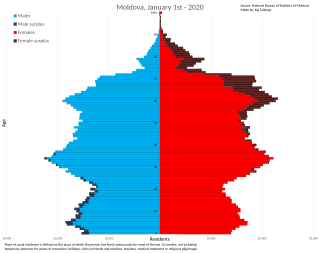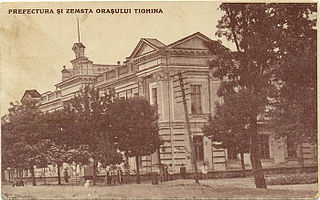Related Research Articles

Demographic features of the population of Republic of Moldova include distribution, ethnicity, languages, religious affiliation and other statistical data.

Moldova, officially the Republic of Moldova, is a landlocked country in Eastern Europe, on the northeastern corner of the Balkans. The country spans a total of 33,483 km2 (12,928 sq mi) and has a population of approximately 2.42 million as of January 2024. Moldova is bordered by Romania to the west and Ukraine to the north, east, and south. The unrecognised breakaway state of Transnistria lies across the Dniester river on the country's eastern border with Ukraine. Moldova is a unitary parliamentary representative democratic republic with its capital in Chișinău, the country's largest city and main cultural and commercial centre.

Bessarabia is a historical region in Eastern Europe, bounded by the Dniester river on the east and the Prut river on the west. About two thirds of Bessarabia lies within modern-day Moldova, with the Budjak region covering the southern coastal region and part of the Ukrainian Chernivtsi Oblast covering a small area in the north.

Transnistria, officially known as the Pridnestrovian Moldavian Republic and locally as Pridnestrovie, is a breakaway state internationally recognized as part of Moldova. It controls most of the narrow strip of land between the Dniester river and the Moldova–Ukraine border, as well as some land on the other side of the river's bank. Its capital and largest city is Tiraspol. Transnistria is officially designated by the Republic of Moldova as the Administrative-Territorial Units of the Left Bank of the Dniester or as Stînga Nistrului.

Gagauzia or Gagauz-Yeri, officially the Autonomous Territorial Unit of Gagauzia (ATUG), is an autonomous territorial unit of Moldova. Its autonomy is intended for the local Gagauz people, a Turkic-speaking, primarily Orthodox Christian ethnic group.
The Gagauz are a Turkic ethnic group native to southern Moldova and southwestern Ukraine (Budjak). Gagauz are mostly Eastern Orthodox Christians. The term Gagauz is also often used as a collective naming of Turkic people living in the Balkans, speaking the Gagauz language, a language separated from Balkan Gagauz Turkish.

Comrat is a city and municipality in Moldova and the capital of the autonomous region of Gagauzia. It is located in the south of the country, on the Ialpug River. In 2014, Comrat's population was 20,113, of which the vast majority are Gagauzians.

Grigoriopol is a town in the Administrative-Territorial Units of the Left Bank of the Dniester, Moldova. It is the seat of the Grigoriopol District of Transnistria. The city is located on the left (eastern) bank of the river Dniester, in central Transnistria.

The Bessarabian Bulgarians are a Bulgarian minority group of the historical region of Bessarabia, inhabiting parts of present-day Ukraine and Moldova.

Tighina County was a county in the Kingdom of Romania between 1925 and 1938 and between 1941 and 1944.
The 2004 Transnistrian census was organized in Transnistria at roughly the same time that Moldova held its own census, which Transnistria refused to participate in out of principle and deference to its September 2, 1990 declaration of independence.
Anti-Romanian sentiment, also known as Romanophobia is hostility, hatred towards, or prejudice against Romanians as an ethnic, linguistic, religious, or perceived ethnic group, and it can range from personal feelings of hatred to institutionalized, violent persecution.

The official state language of Moldova is Romanian, which is the native language of 78.6% of the population ; it is also spoken as a primary language by other ethnic minorities. Gagauz, Russian, and Ukrainian languages are granted official regional status in Gagauzia and/or Transnistria.
Chiriet-Lunga is a commune and village in the Gagauz Autonomous Territorial Unit of the Republic of Moldova. The 2004 census listed the commune as having a population of 2,498 people. Gagauz total 2,312. Minorities included 54 Moldovans, 35 Russians, 32 Ukrainians, 37 Bulgarians and 18 Roma.
Joltai is a commune and village in the Gagauz Autonomous Territorial Unit of the Republic of Moldova. The 2004 census listed the commune as having a population of 2,278 people. Gagauz total 2,187. Minorities included 158 Moldovans, 67 Russians, 33 Ukrainians, 14 Bulgarians, 2 Poles and 1 Jew.
Russians in Moldova form the second largest ethnic minority in the country. According to the Moldovan Census (2004) and a separate 2004 Census in Transnistria, about 370,000 persons identified themselves as ethnic Russians in Moldova.
Cazaclia is a commune and village in the Gagauz Autonomous Territorial Unit of the Republic of Moldova. The 2004 census listed the commune as having a population of 7,043 people. Gagauz total 6,796. Minorities included 56 Moldovans, 53 Russians, 36 Ukrainians, 68 Bulgarians and 34 'other nationality'.

Zăluceni is a village in Florești District, Moldova.
Hlinaia is a village in the Slobozia District of Transnistria, Moldova. It has since 1990 been administered as a part of the breakaway Transnistrian Moldovan Republic. In the 19th century, the village was named Glueckstal and was populated by German Lutheran colonists.
The 2015 Transnistrian census was organized in the unrecognized state of Transnistria in 2015. It was held after Moldova, internationally recognized as the owner of the state's territory, made a census in 2014.
References
- ↑ "Population and Housing Census in the Republic of Moldova, May 12-25, 2014". Population and Housing Census in the Republic of Moldova, May 12-25, 2014. 2 August 2013. Retrieved 3 November 2024.
- 1 2 3 4 5 6 7 8 9 "The Population of the Republic of Moldova at the Time of the Census was 2,998,235". 31 March 2017. Retrieved 3 April 2017. CC-BY-4.0
- ↑ "TRANSNISTRIAN PARLIAMENT ADJOURNS POPULATION CENSUS FOR ONE MORE YEAR". Infotag.md. 5 February 2015. Retrieved 3 November 2024.